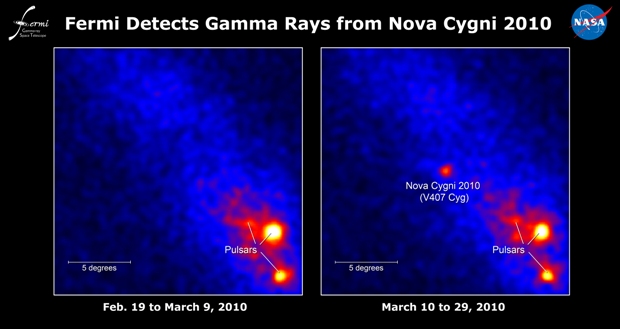On March 11, amateur astronomers Koichi Nishiyama and Fujio Kabashima in Miyaki-cho of Saga Prefecture in Japan imaged a dramatic change in the brightness of V407 Cyg - 10 times brighter than an image they had taken three days earlier.
They contacted Hiroyuki Maehara at Kyoto University, who notified astronomers around the world. Meanwhile, the change was independently reported by three other Japanese amateurs: Tadashi Kojima, Tsumagoi-mura Agatsuma-gun of Gunma prefecture; Kazuo Sakaniwa, Higashichikuma-gun, Nagano prefecture; and Akihiko Tago, Tsuyama-shi of Okayama prefecture.
Fermi's Large Area Telescope (LAT) later detected a new high-energy gamma-ray source at the same location as the nova and the pieces fell into place; the citizen scientists had spied evidence of gamma-rays from a nova for the first time, high-energy radiation which theorists had said novae explosions lack the power to emit.

CLICK IMAGE FOR FULL SIZE. No sign of a nova in 19 days of data prior to March 10 (left), but the eruption is obvious in data from the following 19 days (right). The images show the rate of gamma rays with energies greater than 100 million electron volts (100 MeV); brighter colors indicate higher rates. Credit: NASA/DOE/Fermi LAT Collaboration
"In human terms, this was an immensely powerful eruption, equivalent to about 1,000 times the energy emitted by the sun every year," said Elizabeth Hays, a Fermi deputy project scientist at NASA's Goddard Space Flight Center.
The blast created a hot, dense expanding shell called a shock front, composed of high-speed particles, ionized gas and magnetic fields. According to an early spectrum obtained by Christian Buil at Castanet Tolosan Observatory, France, the nova's shock wave expanded at 7 million miles per hour, 1 percent the speed of light.
The magnetic fields trapped particles within the shell and whipped them up to tremendous energies. Before they could escape, the particles had reached velocities near the speed of light. Scientists say that the gamma rays likely resulted when these accelerated particles smashed into the red giant's wind.
"The red giant is so swollen that its outermost atmosphere is just leaking away into space," said Adam Hill at Joseph Fourier University in Grenoble, France. The phenomenon is similar to the solar wind produced by the sun, but the flow is much stronger. "Each decade, the red giant sheds enough hydrogen gas to equal the mass of Earth," he added.
The white dwarf intercepts and captures some of this gas, which accumulates on its surface. As the gas piles on for decades to centuries, it eventually becomes hot and dense enough to fuse into helium. This energy-producing process triggers a runaway reaction that explodes the accumulated gas.
The white dwarf itself, however, remains intact. Supernovae remnants endure for 100,000 years and affect regions of space thousands of light-years across.
Watch V407 Cyg go nova! Gamma rays (magenta) arise when accelerated particles in the explosion's shock wave crash into the red giant's stellar wind. Credit: NASA/Goddard Space Flight Center/ Conceptual Image Lab.
"We know that the remnants of much more powerful supernova explosions can trap and accelerate particles like this, but no one suspected that the magnetic fields in novae were strong enough to do it as well," said NRL's Soebur Razzaque.
Citation: The Fermi-LAT Collaboration, 'Gamma-Ray Emission Concurrent with the Nova in the Symbiotic Binary V407 Cygni', Science 13 August 2010:Vol. 329. no. 5993, pp. 817 - 821 DOI: 10.1126/science.1192537





Comments